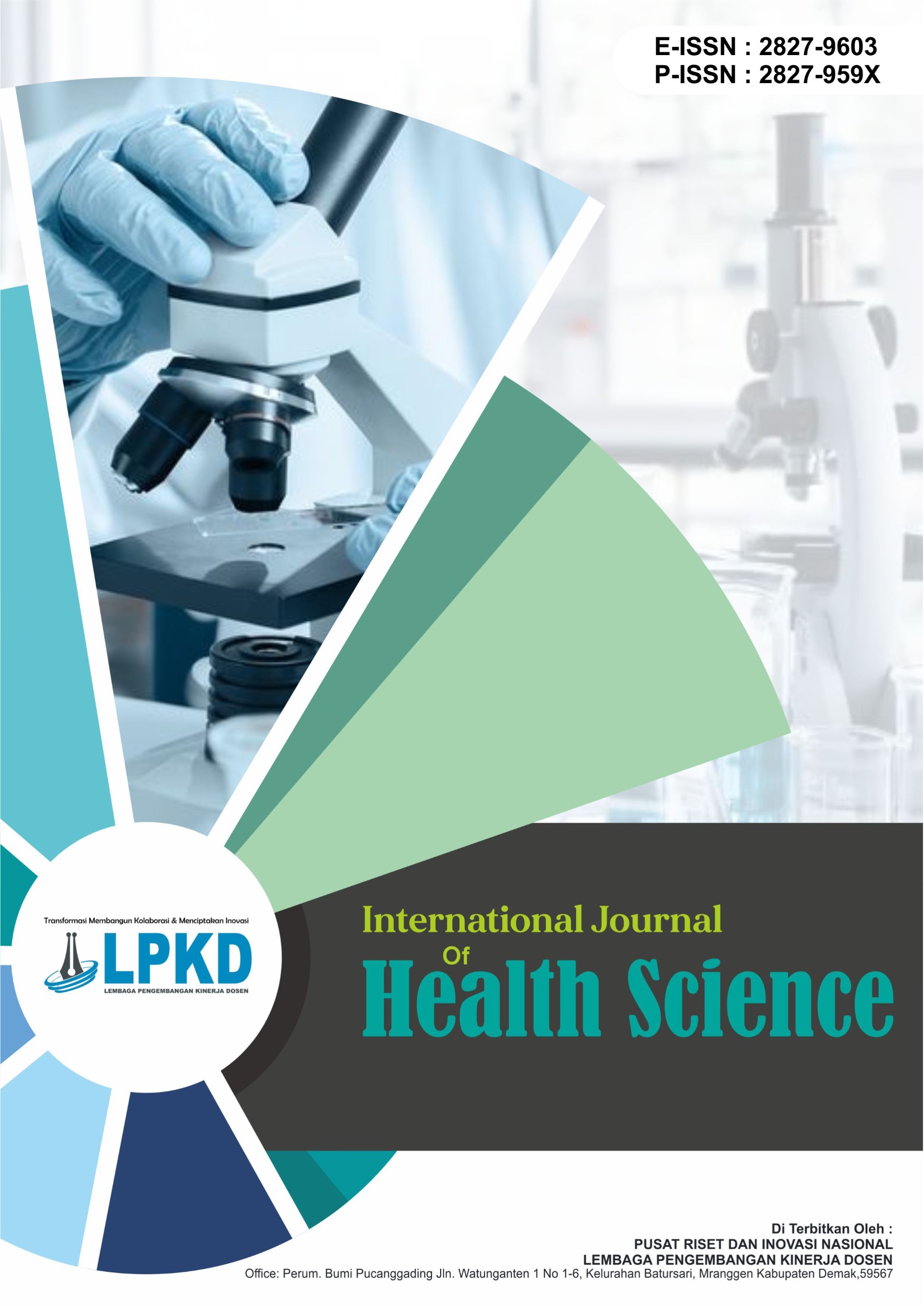Analysis of Environmental Health Risks from Pesticide Exposure among Green Mustard Farmers in Ngkari-Ngkari Village, Baubau City
DOI:
https://doi.org/10.55606/ijhs.v5i3.6010Keywords:
Analysis Environmental Health Risks (ARKL); Pesticides Green Mustard Greens; Environmental Health Risk Assessment (EHRA); Pesticide; Green MustardAbstract
Ngkari-Ngkari Sub-district is an agricultural area that produces rice, fruits, and vegetables, particularly green mustard (caisin), with a population composed of diverse ethnic groups. The use of pesticides in agricultural activities may pose health risks when applied improperly. This study aims to analyze environmental health risks due to pesticide exposure among green mustard farmers in Ngkari-Ngkari, Baubau City. Plant samples were collected two days after chemical pesticide spraying using standard procedures and analyzed at the UHO Pharmacy Laboratory. A total of 64 farmers were selected through total sampling, and data were obtained using structured questionnaires. Data analysis employed SPSS and the Environmental Health Risk Assessment (EHRA) method. Laboratory results indicated that pesticide concentration in green mustard plants was 0 mg/kg/day or undetected. The estimated intake exposure among farmers was 0.000364 mg/kg/day, while the calculated risk quotient (RQ) of Chlorpyrifos exposure was 0.0121 mg/kg/day. An RQ value ≤ 1 suggests that the 64 farmers were not at risk of adverse health effects from exposure to Chlorpyrifos-based pesticides. This study concludes that pesticide use in Ngkari-Ngkari remains within safe limits for farmers, although continuous monitoring and proper application are necessary to prevent long-term cumulative risks. Limitations of this study include the influence of environmental factors during sampling and the potential effect of sample storage time, indicating the need for biological monitoring and soil condition evaluation in future studies to strengthen the findings.
Downloads
References
Apriliani, E. A., Oktavidiati, E., Ramon, A., & Wati, N. (2021). Description of vegetable farmers’ behavior in the Nusa Indah Community Health Center working area as perceived from a health aspect. Avicenna Jurnal Ilmiah, 16(1), 34–45. https://doi.org/10.36085/avicenna.v16i1.1567
Dirgayana, I. W., Sumiartha, I. K., & Adnyana, I. M. M. (2017). Efficacy of insecticides with active ingredients (chlorpyrifos 540 g/l and cypermethrin 60 g/l) on population development and attacks of the leaf roller pest Lamprosema indicata Fabricius (Lepidoptera: Pyralidae) on soybean plants. E-Jurnal Agroekoteknologi Tropika, 6(4), 378–388.
Ibrahim, I., & Sillehu, S. (2022). Identification of chemical pesticide use activities that pose a health risk to horticultural farmers. JUMANTIK: Jurnal Ilmiah Penelitian Kesehatan, 7(1), 7. https://doi.org/10.30829/jumantik.v7i1.10332
Inayah, I., & Nirmala, N. (2017). Identification of chlorpyrifos pesticide residues in green mustard greens (Brassica rapa var. parachinensis L.) at the Eggplant Market in Makassar City in 2016. Jurnal Sulolipu: Media Komunikasi Sivitas Akademika dan Masyarakat, 17(1).
Mahyuni, E. L. (2015). Risk factors in pesticide use on health complaints in farmers in Berastagi District, Karo Regency 2014. Kesmas: Jurnal Kesehatan Masyarakat Nasional, 9(1), 79–89.
Muawanah, M., Rasyid, N. Q., & Hasma, H. (2024). Determination of chlorpyrifos and carbofuran pesticide residues in vegetables in Makassar traditional markets. Media Kesehatan Politeknik Kesehatan Makassar, 19(2), 152–157. https://doi.org/10.32382/medkes.v19i2
Murdolelono, S. L., Kapa, M. M. J., & Bano, M. (2021). Technical efficiency of production input use in mustard greens farming (Case of Baumata Village, Taebenu District, Kupang Regency, NTT). Jurnal Sosial Ekonomi Pertanian (JASE), 2(1), 43. https://doi.org/10.33474/jase.v2i1.7799
Nguyen, D. G., et al. (2022). Assessment of pesticide use and pesticide residues in vegetables from two provinces in Central Vietnam. PLOS ONE, 17(6), e0269789. https://doi.org/10.1371/journal.pone.0269789
Ndalewoa, B. L., Daud, A., & Ruslan. (2013). Identification of chlorpyrifos in green mustard greens at Terong Market and Mtos Supermarket, Makassar (pp. 1–8).
Noppakun, K., & Juntarawijit, C. (2022). Association between pesticide exposure and obesity: A cross-sectional study of 20,295 farmers in Thailand [version 3; peer review: 2 approved, 1 not approved]. F1000Research, 10(445), 1–35. https://doi.org/10.12688
Nur, S. (2020). Analysis of chlorpyrifos pesticide residue content in green mustard (Brassica rapa var. parachinensis L.) using the UV-Vis spectrophotometry method. Scientific Paper.
PERMENKES. (2014). Regulation of the Minister of Health of the Republic of Indonesia Number 41 of 2014 Concerning Balanced Nutrition. Regulation Database. https://peraturan.bpk.go.id/Home/Details/119080/permenkes-no-41-tahun-2014
Rahmah, S. P., & Nabila, N. (2020). Risk analysis of pesticide exposure in vegetable farmers in Alahan Panjang. Jurnal Kesehatan dan Keselamatan Kerja Lingkungan (JK3L), 1(1). http://jk3l.fkm.unand.ac.id/
Rachmidiani, F. (2021). Health risk analysis of lead exposure in water spinach on farmers in Sukapura Village, North Jakarta in 2019. Jurnal Nasional Kesehatan Lingkungan Global, 2(2). https://doi.org/10.7454/jnklg.v2i3.1006
Sari, H. P., Suhartono, S., & Raharjo, M. (2023). Exposure to organophosphate pesticides on cholinesterase levels during spraying. Journal of Telenursing (JOTING), 5(2), 2999–3007. https://doi.org/10.31539/joting.v5i2.7703
Shaleha, B. A., Afifah, F., Salamah, N. P., NurSehha, S., Rozni, H. N., & Sulistyorini, D. (2023). Potential impact of pesticide residue content on vegetables and fruits: A literature study. Indonesian Journal of Biomedical Science and Health, 3(1), 1–10. https://doi.org/10.31331/IJBSH.v31i1.2551
Sinambela, B. R. (2024). The impact of pesticide use in agricultural activities on the environment and health. AGROTEK: Jurnal Ilmiah Ilmu Pertanian, 8(1), 76–85. https://doi.org/10.33096/agrotek.v8i1.478
Siswanto, Y., Petiwi, K. D., & Lestari, S. (2024). Pesticide exposure and the incidence of mild cognitive impairment (MCI) in adolescents in agricultural areas in Sumowono District. Health: Jurnal Ilmiah Kesehatan, 6(2), 85–91.
Smegal, D. C. (2000). Human health risk assessment of chlorpyrifos. U.S. Environmental Protection Agency.
Suluh, D. G., Telan, A. B., & Sadukh, J. J. P. (2021). Analysis of factors influencing pesticide content in agricultural products in Kupang Regency in 2019. Jurnal Penelitian Kesehatan Lingkungan, 4(2), 1–10.
Syed, J. H., et al. (2014). Pesticide residues in fruits and vegetables from Pakistan: A review of the occurrence and associated human health risks. Environmental Science and Pollution Research, 21(23), 13367–13393. https://doi.org/10.1007/s11356-014-3117-z
Tarigan, W. Y. B., Siregar, S. D., & Hartono, H. (2024). The relationship between education, training, knowledge, economic factors and the use of PPE in the use of pesticides in Cinta Rakyat Village in 2023. Jurnal Kesehatan Tambusai, 5(3).
Downloads
Published
How to Cite
Issue
Section
License
Copyright (c) 2025 International Journal Of Health Science

This work is licensed under a Creative Commons Attribution-ShareAlike 4.0 International License.







